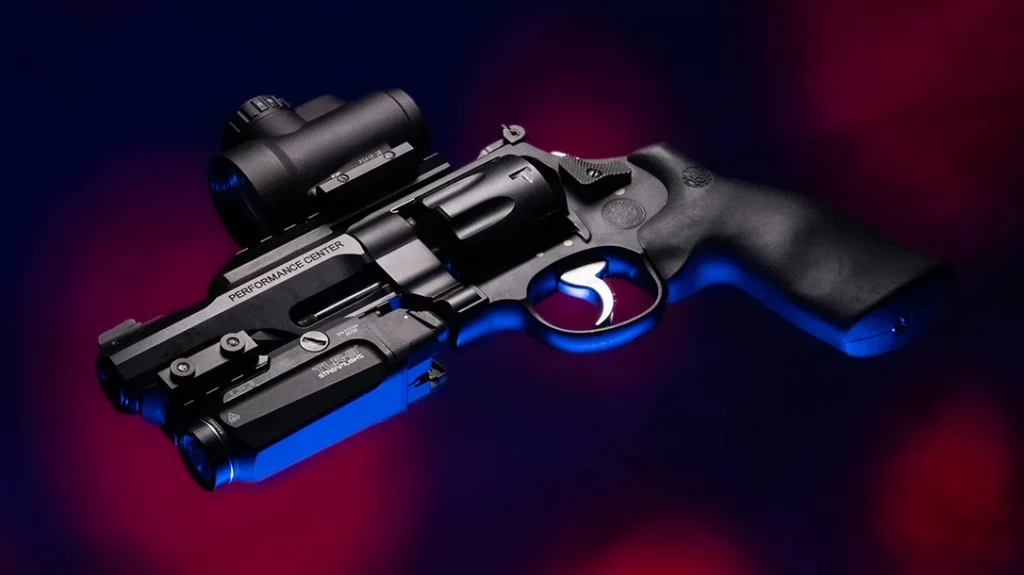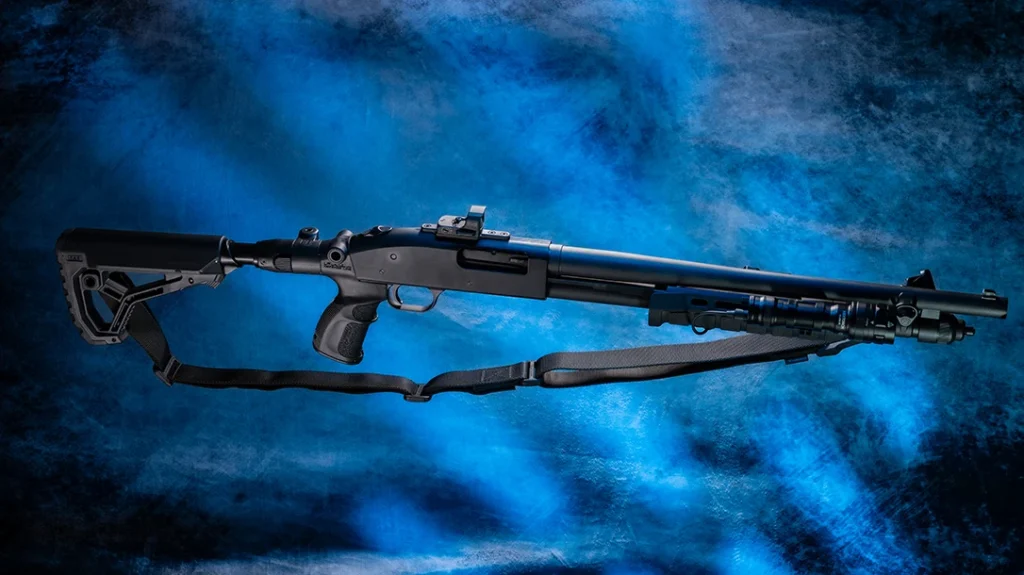Precision tactical rifles are a growth industry these days with many manufacturers turning out both production and custom-built rifles capable of meeting the basic criterion of minute of angle (MOA) accuracy out of the box. The price of entry can be several thousand dollars for a base rifle, but as we’ll presently see there is a new act in town that not only delivers the goods in terms of accuracy but also at an affordable price, considering what’s included.
 This is Halo Arms’ recently introduced Free Float Bolt Action Rifle (F-BAR) that represents true “outside the box” innovative thinking. This is evident from Halo Arms’ design as soon as one lays eyes on the rifle. The F-BAR has so many innovative features it is difficult to know where to begin on this rifle.
This is Halo Arms’ recently introduced Free Float Bolt Action Rifle (F-BAR) that represents true “outside the box” innovative thinking. This is evident from Halo Arms’ design as soon as one lays eyes on the rifle. The F-BAR has so many innovative features it is difficult to know where to begin on this rifle.
The most obvious feature of the F-BAR is the stock, which is machined from forged aluminum. Aluminum is lightweight, stiff and dimensionally sound under all environmental extremes, plus providing integral mounting points that are adjustable without compromising strength and weight. Along with its free float tube, the stiffness of Halo’s mounting system is one of the keys to the rifle’s accuracy.
Advertisement — Continue Reading Below
The free float tube surrounds the barrel and is totally isolated, allowing MIL-STD-1913 rails to be fitted at top, bottom and sides. Although our test rifle did not have a full-length MIL-STD-1913 top rail, the mounting points for a full-length rail are present, as is the case on both sides and the bottom. Our test rifle had partial rails on both sides and on the bottom. Any precision tactical rifle should be equipped with a full-length top rail as standard equipment. This is a minor criticism, as a rail can be reasonably purchased and installed.
The F-BAR has a standard AR pistol grip and is fully adjustable for cheek rest height and length-of-pull (LOP). The adjustable cheek rest and LOP enables the user to tailor the F-BAR to just about any physical configuration. We should note that the F-BAR’s adjustable cheek rest does not interfere with removing the rifle’s bolt for cleaning and maintenance. This is a welcome feature that many manufacturers overlook.
The F-BAR’s recoil pad is a Pachmayr unit with an aggressive pattern that helps position the rifle in the shooter’s shoulder. The stock also positions the barreled action lower than a standard design stock so the recoil forces are delivered in virtually a straight line, minimizing felt recoil and muzzle rise. These two issues are vitally important in any tactical rifle because reduction of both is a key factor in attaining quick follow-up shots.
Advertisement — Continue Reading Below
Our test rifle came with the optional adjustable rear monopod. Some shooters like monopods because of the added stability and, while we understand their purpose, we prefer to shoot without a monopod. This isn’t a criticism, merely to point out that the monopod is there if you want it. The bottom line with the F-BAR is that the user can configure the rifle any way he or she wants it.
The stock is finished in KG Industries black GunKote, a proprietary finish originally developed for military weapons and a leader in thin film coatings for firearms. GunKote provides better all-around protection than bluing or phosphate finishes with better resistance to abrasion, chemicals, oils and solvents plus the ability to take a 500- to 1000-hour salt spray test of a 5 percent solution simulating seawater depending the substrate material. Besides basic black, GunKote is available in several colors and is also available in an Air Cure version.
Howa Action
The F-BAR action is a Howa 1500, chosen for a number of reasons. The Howa action is a high quality unit that serves as the basis for such well-known quality rifles as Weatherby’s Vanguard series. The Howa barreled action offers high quality at a reasonable price, hence its inclusion in the F-BAR package. Besides quality, the Howa rifle is capable of sub-MOA accuracy right from the box. Another feature of the Howa action is that the receiver is milled flat on the bottom, providing a broad area that ensures solid contact with the aluminum stock’s precision mating surface.
Advertisement — Continue Reading Below
In use, the Howa is similar to the familiar Remington 700 with a few differences. The Howa’s safety selector has three positions. The forward position is fire, plus there are two safety positions. The intermediate safe position allows the bolt to be manipulated with the rifle on safe, while the rear-most position locks up everything. Bolt removal is also different with the Howa action. The bolt is removed by pressing in on a small button at the left rear of the receiver and holding it down while drawing the bolt to the rear and out of the receiver.
The action itself is butter smooth. Halo Arms uses the standard Howa trigger mechanism, but tuned to break at 2.5 to 3 pounds, which is just about ideal for a precision tactical rifle. Our test rifle’s trigger broke at a consistent crisp 2.5 pounds with a tiny bit of creep and no overtravel.
Optics Selection
We equipped our test F-BAR with a U.S. Optics SN3S 3.2-17x scope with optional illuminated reticle and Horus Vision H-25 military reticle. The U.S. Optics scope is designed for target engagement to 1000-plus yards/meters, which is ideal for a precision tactical rifle. The SN3 scope body is made from 6061-T6 aluminum and it is finished in Type III hard anodizing. Elevation and windage knob components are a combination of stainless steel, brass and 4130 chrome moly steel with tungsten carbine ball detents. The SN3 scope is large and relatively heavy, but it will take the punishment of any caliber rifle’s recoil and keep coming back for more.
Advertisement — Continue Reading Below
The Horus Vision sighting system uses a patented targeting grid in conjunction with a Palm PDA to take all guesswork out of “come-ups” and is such an improvement over traditional mil-dot scopes that it defies description. The Horus grid is in standard milliradians, but does away with the USMC “footballs” and Army “baseballs” in favor of mils precisely divided into wide hackmarks for each milliradian, which are further subtended into 0.2 mil increments by smaller hackmarks. These make ranging via mils much more precise, although most military precision tactical marksmen of our acquaintance use laser rangefinders.
The Horus Vision system does away with turning knobs to dial in come-ups. All that is necessary is to obtain the distance to the target, dope the wind and use either the PDA with Horus Vision ballistic software or previously prepared come-up card to determine the hold. As long as the shooter is using the same load in his rifle, he need not touch the windage and elevation knobs. Even when changing from one caliber to another, the Horus Vision H25 reticle enables the shooter to leave the knobs alone provided he has previously zeroed the rifle with each caliber and prepared a Horus Vision “come-up card” showing zero and holds.
Since our Halo Arms F-BAR lacked a full-length MIL-STD-1913 rail for use with night vision sights, we used a LaRue Tactical Sniper Total Optical Mounting Package (STOMP) scope mount. The STOMP mount not only can be removed and replaced if necessary with less than 1-MOA change in zero via LaRue’s adjustable QD (quick detach) throw levers, but has a “cage” that partially protects the scope and a MIL-STD-1913 rail that extends forward of the scope so an AN/PVS-22 can be mounted.
Advertisement — Continue Reading Below
Two From Leupold
In addition to our U.S. Optics tactical riflescope, we opted for two Leupold optical products that we consider essential to any precision tactical rifle team. First is Leupold’s 750-meter/yard RX II laser rangefinder. Although most precision tactical marksmen are trained to use mil-dots, several active duty Army individuals have told us that in operational conditions, they use laser rangefinders because they are just more accurate and faster on target. Laser rangefinders like Leupold’s 750-yard/meter RX II and 1200-yard/meter RX III rangefinders do much more than just indicate range, though.
These pocketsize rangefinders also calculate true ballistic range when shooting on a slope, either up or down. Previously, this required a mathematical calculation that, while simple, took time and in a tactical situation, time is everything. Leupold’s RX rangefinders display this critical information instantly, which is especially valuable in operations where slope shooting is required – Northern Afghanistan or shooting up or down in an urban environment come to mind. In fact, every operational precision tactical marksman we know uses a laser rangefinder to determine target distance.
We also used a Leupold Mark 4 12-40x60mm tactical spotting scope with the H25 reticle. The matching reticles make second shot corrections a breeze. Finally, no team is complete without a pair of quality binoculars and Leupold’s Olympic 10×50 binoculars are an excellent choice. These binoculars can be adjusted to just about any eye relief and are lightweight, rugged and waterproof.
Advertisement — Continue Reading Below
We also added Optical System Technology’s AN/PVS-22 Universal Night Sight (UNS), probably the best all-around piece of image-intensifying (I²) night vision equipment available because it can be used as a hand-held night vision optic or as a small arms sight. The UNS is about half the size and weight of a SIMRAD, but has similar performance. Although the AN/PVS-22 is only slightly larger than an AN/PVS-14, it overshadows the AN/PVS-14’s performance in every way.
The AN/PVS-22 has absolutely zero “sparkles,” “blooms” or lines and when used as a night sight, mounts ahead of the day optic, eliminating eye relief issues associated with the AN/PVS-14 that must be mounted to the scope using an adapter. Besides eye relief, forward mounting allows the day optic to be used in darkness without either visible or IR reticle illumination.
Our final addition was a Versa-Pod Model 91 “Raptor” military specification bipod with large claw feet that will not sink in to just about any surface and can be used as an impact weapon when extended. The Raptor bipod was designed for use with the military’s M249 light machine gun, is made of steel and mates to any MIL-STD-1913 rail.
Advertisement — Continue Reading Below
The legs are spring loaded, fully adjustable from 9 inches collapsed to 12 inches fully extended with intermediate notches to allow the bipod to be locked into any one of five alternate positions between collapsed and fully extended. The Raptor has built-in cant adjustment with a friction lock to hold it in place once the desired cant is achieved. Sales of the Raptor are restricted to military and law enforcement.
How It Shoots
With our F-BAR set up as we like it, we headed to the range. Shooting Halo’s F-BAR was uneventful. The rifle performed with total reliability and excellent accuracy. In sum, Halo’s F-BAR rifle is a truly innovative rifle that represents what can be achieved at a reasonable price when one steps “outside the box” and starts with a clean sheet of paper.
Although the Halo Arms F-BAR rifle at its heart is a conventional bolt-action rifle, it looks and is one of the most innovative designs we have seen in many years. Hats off to Halo Arms for creating a reasonably priced shooting machine!
























